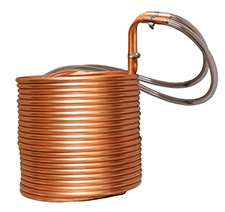What is Cold Crashing in Beer Making?
Posted by Matteo Lahm on 4th Nov 2024
Ever wondered how your favorite brew gets that crystal-clear look and crisp taste? Well, it's all thanks to a nifty process called 'cold crashing'. It's like a winter vacation for your beer, and it's got nothing to do with snowboarding!
If you want your beers to have the same quality and clarity as commercial beers, cold crashing is a must. Looking at beer that has not undergone a cold crash is like looking through a foggy window on a rainy day. The beer has a murky, hazy appearance, almost like a snow globe after you've given it a good shake. The clarity that you're used to seeing in your favorite commercial beers is missing.
Now, take a sip. The taste might surprise you. Without cold crashing, the beer can have a yeasty, grainy flavor. It's like biting into a loaf of bread that's still doughy in the middle. The flavors haven't had a chance to fully settle and mature, so they're all jumbled together.

So, while skipping the cold crash might save you some time, it's clear that this step is crucial for achieving that clean, crisp beer taste and look we all love.
Think of cold crashing as the beer equivalent of a quick spa retreat. It's when you rapidly lower the temperature of your finished beer before bottling, kegging, and carbonating it. This process, typically taking your beer to just above freezing, is done once the beer has hit its terminal gravity.
This frosty technique has its roots in the cold aging process of lager beer styles. But now, it's used for many ales and is a popular trick in the commercial brewing world. Why? Because not only does it give your beer that crystal-clear look, but it also reduces the aging time.
So, how does cold crashing work? It's all about the science of solids and temperatures, and the star of the show is the yeast. Cold crashing triggers a survival reaction in yeast that forces them to 'flocculate' or clump together. These larger clumps fall out more quickly due to Stokes law, which says that larger particles have a higher settling velocity. It's like a yeast party where everyone clusters together and then passes out, but without the hangover!
 This is why you should don't confuse a cold break with cold crashing. They are two very different processes that happen at different stages of your beer making process. The cold break happens right after the boil, when you rapidly cool your wort to encourage proteins, tannins, and other solids to clump together and fall out of the solution. On the other hand, cold crashing is a post-fermentation process. It is important to understand that the cold break, removes most of the solids and grain tannins, but not all and, wort does not have yeast. So even if you do cold breaks, the cold crash is a different process that removes solids like yeasts that are present after fermentation. It also removes the remainder of proteins and tannins that may have not dropped out during the cold break. Since rapid cooling assists in the cold crash process, you can use your wort chiller to rapidly cool your beer before you refrigerate it. The faster you shock the yeast, the better they will clump together and drop out of your beer.
This is why you should don't confuse a cold break with cold crashing. They are two very different processes that happen at different stages of your beer making process. The cold break happens right after the boil, when you rapidly cool your wort to encourage proteins, tannins, and other solids to clump together and fall out of the solution. On the other hand, cold crashing is a post-fermentation process. It is important to understand that the cold break, removes most of the solids and grain tannins, but not all and, wort does not have yeast. So even if you do cold breaks, the cold crash is a different process that removes solids like yeasts that are present after fermentation. It also removes the remainder of proteins and tannins that may have not dropped out during the cold break. Since rapid cooling assists in the cold crash process, you can use your wort chiller to rapidly cool your beer before you refrigerate it. The faster you shock the yeast, the better they will clump together and drop out of your beer.
The length of cold crashing can vary, but most brewers go for several days. Though some suggest that it can go longer, 2-3 days is the advisable limit. Leaving it too long can lead to complications later in your process. While cold crashing will drop a lot of yeast out, you do not want to lose too much of it because you need some present for the bottle conditioning phase. It is also advisable to use a yeast with low to medium flocculation.
Aim to get your beer as close to freezing as possible, without actually freezing it. This is very important. Freezing your beer can cause a whole host of problems. The water in the beer might freeze, but the alcohol won't, leading to a concentration of flavors that can throw off the balance of your brew. Plus, the expansion that occurs during freezing can lead to burst carboys or damaged kegs. So, while cold crashing is a cool technique, remember to not get greedy. You want your beer chilled, not frozen. It's like a refreshing dip in the pool, not a plunge into the Arctic Ocean!
On a side note, be careful with your airlock during cold crashing. A one-way airlock can result in negative pressure and suck liquid into your fermenter. It's best to use a two-way airlock or some sanitized foil to avoid this problem.
Lastly, if you are going to dry hop, do it after you cold crash. The cold temperatures make it harder to get aroma oils in the beer, and dry hopping closer to bottling will preserve more subtleties. It's like the final flourish on your beer masterpiece.
So that’s the cool scoop on cold crashing your beer. It's a simple, effective way to improve the clarity and taste of your beer. Cheers!

